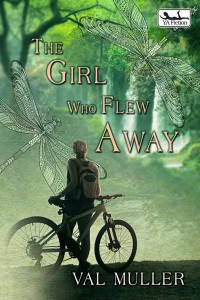Writer Wednesdays: Like the Leafy Seadragon

Can you spot the leafy seadragon? Photo taken during my trip to Ripley’s Aquarium in South Carolina.
The first time I saw a leafy seadragon, I was fascinated. It’s a fish in the same family as a seahorse, and it’s covered in leaf-like growths that help camouflage it in the waters near Australia, where it lives. For me, the leafy seadragon held the same fascination that captivates the protagonist in The Life of Pi. That there could be a creature so magnificent that it’s made to look like something else—well, what a powerful world we inhabit! Each time I visit a zoo, my appreciation for the amazing animals of this earth increases with age. Even for a fiction writer, there is nothing more inspiring for the imagination than reality.
I borrowed the leafy seadragon as a metaphor in my YA novel The Girl Who Flew Away. In it, the main character Steffie doesn’t want to stand out. She spends much of her life flying under the radar, but that means she’s bound not to be herself.
But it turns out she’s more like a leafy seadragon—blending into a forest with all the other vegetation when in fact she is something far more spectacular once her true identity is known.

No good deed goes unpunished when freshman Steffie Brenner offers to give her awkward new neighbor a ride home after her first day at school. When her older sister Ali stops at a local park to apply for a job, Steffie and Madison slip out of the car to explore the park—and Madison vanishes.
Already in trouble for a speeding ticket, Ali insists that Steffie say nothing about Madison’s disappearance. Even when Madison’s mother comes looking for her. Even when the police question them.
Some secrets are hard to hide, though—especially with Madison’s life on the line. As she struggles between coming clean or going along with her manipulative sister’s plan, Steffie begins to question if she or anyone else is really who she thought they were. After all, the Steffie she used to know would never lie about being the last person to see Madison alive—nor would she abandon a friend in the woods: alone, cold, injured, or even worse.
But when Steffie learns an even deeper secret about her own past, a missing person seems like the least of her worries…
I think in many ways we’re all struggling to find the balance between blending in and standing out. I remember one of the most terrifying discussions I had as a kid. Some of the kids at school were asking who “still plays with toys.” I remember staying quiet during the conversation and then going home and feeling remotely guilty that I still took so much joy in abandoning my “grown up” persona of the schoolyard and enjoying some quality time with my toys.
My dresser became a perilous mountain that my little rubber and plastic figures would scale. The area under my bed became a dreary cave where all my more sinister toys lurked. On the desk chair, several characters had set up various shops, offering a market for the other toys to find their groceries. I rehearsed the archetypal journey as characters left home, scaled the mountain, defeated the lurkers under the bed, and stopped at the market on the way home, victorious.
And then I had to go to school the next day and pretend I was too good for toys.
Now, I dorkily embrace my true nature. My house is still filled with toys and trinkets: Jack Skellington, models of the TARDIS and Doc Brown’s DeLorean (in all three of its iterations, including a Lego version). In fact, it’s not always easy for someone to tell which toys are “mine” and which are my daughter’s.
As a reader, I find so much hope and comfort in reading of the trials and triumphs of other characters. Each character’s experiences are like a life I get to live without actually spending mine. And then, when I encounter my own problems, I draw on the wisdom of a thousand characters to help guide me.
As a writer, I try to offer hope to others. Many of my characters struggle between being themselves and allowing their “inner awesome” to emerge, and following the standards that everyone else seems to obey—even when those standards are detrimental. Perhaps one day, a reader will be confronted with a life challenge and instead of flying under the radar, they will allow their inner seadragon to emerge.
Now through July 4, The Girl Who Flew Away is only $1.99 everywhere books are sold, including Amazon.com and Barking Rain Press.
Leave a Reply